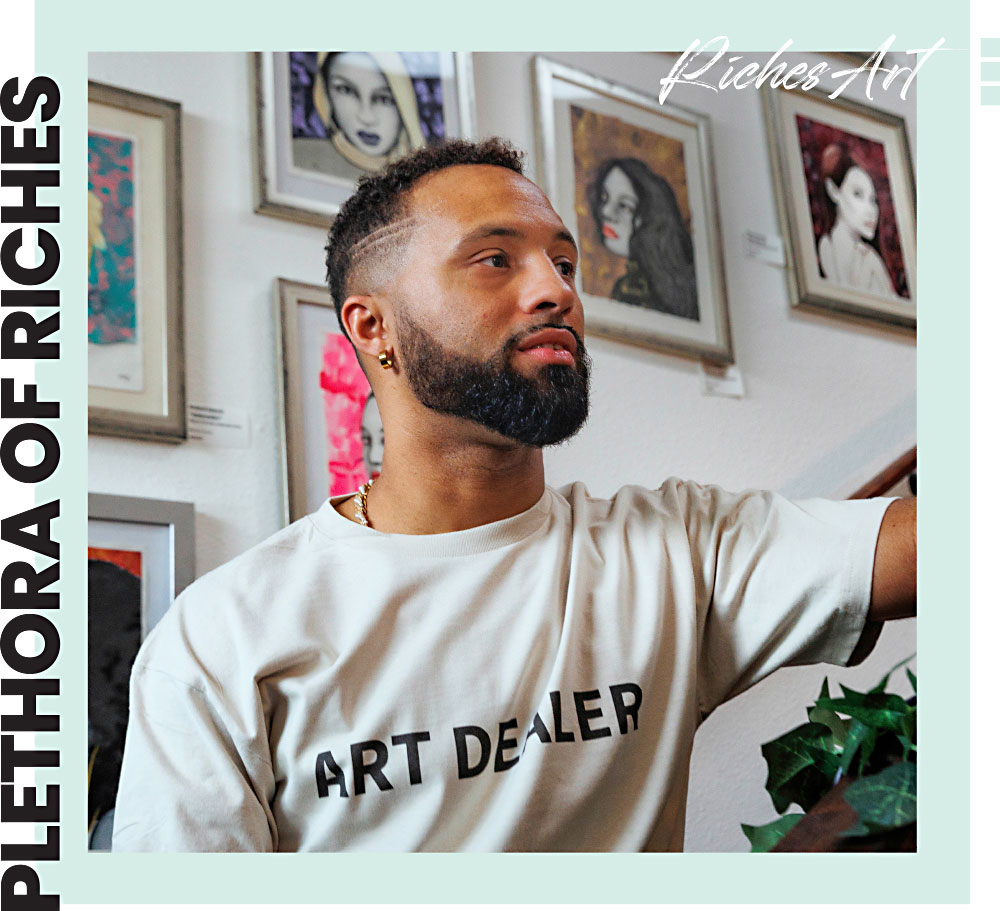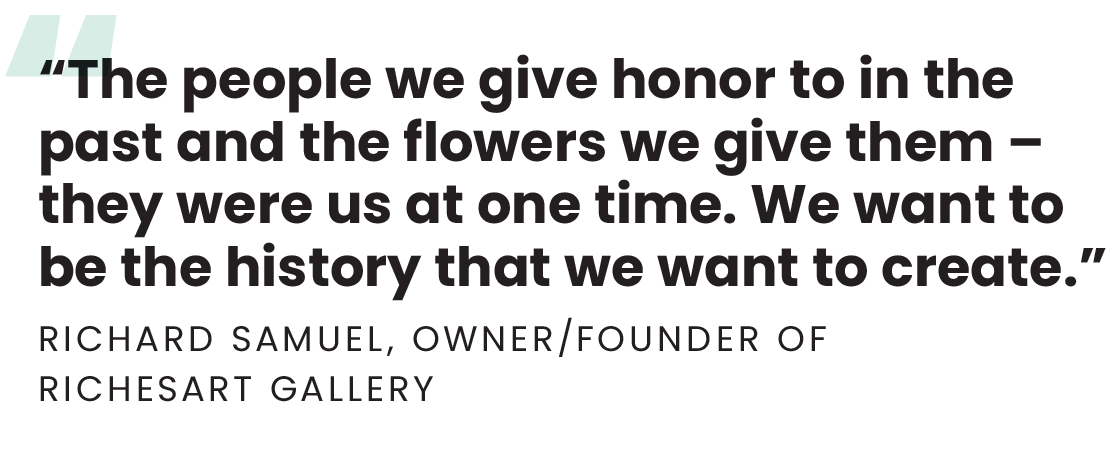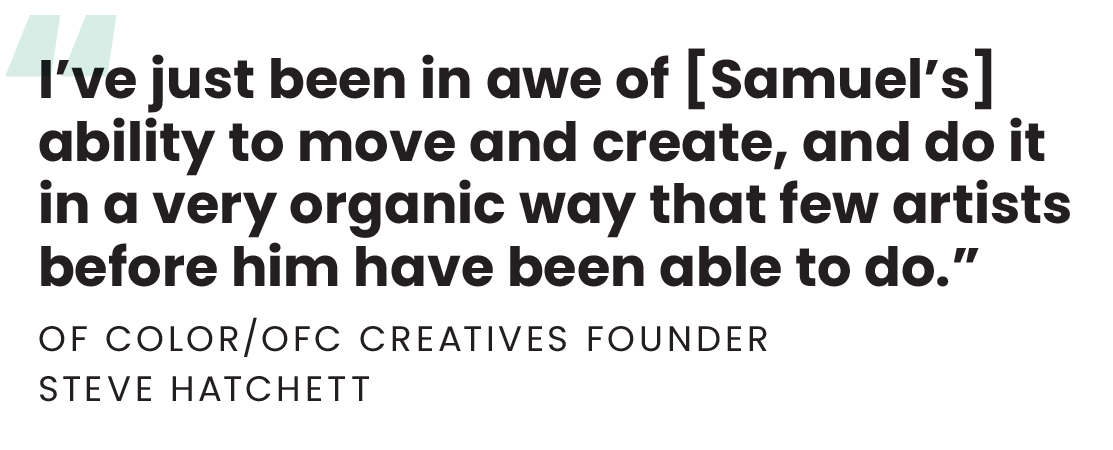Plethora of Riches: How Richard Samuel Turned an Art Gallery Into a Community Center
RichesArt launches annual Black History Month exhibit with new philanthropic initiative
By Carys Anderson, Fri., Feb. 9, 2024
White walls, fluorescent lights, the occasional “keep your distance” line of tape on the floor: Most art galleries present one of life’s greatest pleasures – witnessing artistic creations up close – with a healthy dose of restrictions. Keep quiet, and keep your hands to yourself.
Stepping into RichesArt Gallery (2511-A E. Sixth), you don’t tense up with that same anxiety. Hues of blue and red illuminate the East Sixth Street space. Luscious green plants decorate the walls not already adorned with art. In lieu of silence – or, worse, inoffensive adult contemporary – neo-soul and melodic hip-hop reverberates.
The biggest difference? RichesArt visitors can do more than spectate. The art gallery – founded by artist Richard Samuel in 2021 – is open to the public from Friday through Sunday, but during the week, it becomes an event space, home to watercolor painting, figure drawing, and collage making classes, as well as comedy shows, jazz performances, and poetry readings.
Of course, an art gallery needs art buyers, and these activities bring people in the door. But Samuel wants his visitors to do more than purchase the art. He wants them to “network, talk, imagine, be curious.”
Turns out, networking, talking, imagining, and being curious are the building blocks of a community. In the past three years, RichesArt – which until 2023 was the only Black-owned art gallery in Austin – has become a third place: a gathering spot outside of work and home for people to hang out. It’s also become a launching pad for creatives of color. On Feb. 3, the gallery opened its third annual Black History Month exhibit, “American History: Elevate,” which displays the work of six local Black artists.
Heike Blakley, one of the artists involved in the exhibit, has lived in Austin for five years, but she’s rarely encountered arts institutions that have supported her work. Most galleries don’t understand the Black and brown communities, and they aren’t trying to improve. “They’re just not open to a different brand of what they already have,” she says. “And honestly, it’s boring.”
RichesArt offers a welcome change of pace. “It’s exactly what I would imagine an art gallery feeling like,” Blakley says.

Cliff Bunn, 62, moved to Texas in 2014 after retiring from the Oakland Police Department. Living in Georgetown, he says, I don’t have a community of artists or a lot of other Black people. So [when] I heard about RichesArt Gallery, I couldn’t wait to get there.” Upon his arrival, he introduced himself to Samuel, told him he was an artist, and hoped to submit his work to the gallery. “American History: Elevate” marks his fourth RichesArt collaboration.
“It feels like a family atmosphere,” Bunn says of the space.
A Yin and a Yang
Samuel, 35, grew up in Wimberley, a town about 40 miles southwest of Austin whose population has yet to breach 3,000. He grew up playing football and earned a full-ride scholarship to play the game at Texas Southern University, but wasn’t recruited by the NFL. Instead, he went on to represent America in international competitions before joining teams in Serbia and Germany.
The whole time, art was Samuel’s other main interest – “my peace,” as he puts it. “It was like a yin and a yang,” the owner recalls. “I would go to football practice, I’d come home, I’d paint.”
Though he followed an athletic career path, Samuel attended poetry nights, jazz shows, and art galleries as a kid, which meant becoming an artist never felt out of his grasp. His mother, Christa, even preferred he pursue that goal instead of football and bought him art supplies “left and right.”
“I think [she] had a heart attack every time I was on the field because of the collisions,” Samuel reasons, laughing. “So half that decision might have been to save her own stress, like, 'Please do something nicer!’”
Christa’s support went beyond providing materials. During her son’s senior year of high school, she signed him up for a watercolor workshop led by Lian Quan Zhen, the esteemed Chinese artist who’s taught at the University of California, Berkeley and authored several books. Samuel missed a week of school to attend the class.
“It was like every lightbulb went off in my head as a kid, watching this guy create this art,” he recalls. “And I’ve been obsessed with watercolor ever since.”
He continued to create during his professional football career and sold original pieces even before retiring from the game in 2018. Once free from football, Samuel adapted Zhen’s watercolor curriculum and began teaching classes of his own.
“Everything was going great,” Samuel remembers. “And then I got a head coaching job for a team overseas.”
The athlete always expected to transition to coaching once he stepped off the field, so he accepted the offer and headed back to Germany. But “I was miserable,” he reveals. “I hated it.”
In March of 2021, after working for four months as an offensive coordinator for the Ingolstadt Dukes, Samuel accepted that, maybe, art had topped football on his list of priorities once and for all. He returned to Texas and, using his pandemic-era Paycheck Protection Program loan, began seeking a brick-and-mortar to host his watercolor classes. In a stroke of “crazy luck,” he found the East Sixth Street space listed on Craigslist for the exact same amount as the loan.
“I guess I’m opening an art gallery.”

“There Was No Playbook”
Progressing from artist to art curator is a big jump as it is, but when RichesArt first opened, Samuel was also organizing all of the gallery’s events himself. “That was probably the biggest thing that I had issues with – there was nobody that has done anything like what I was doing here, around Austin,” he says. “Obviously [I practiced] networking and building community [and] started meeting people that helped elevate the space, but there was no playbook.”
These days, Samuel delegates the organizing of RichesArt events to a handful of collaborators. He teaches the gallery’s watercolor and figure drawing classes, Steven Ecker leads its collage making workshops, and Destini Cook offers modeling advice. On the entertainment side, Galen Ford teaches an art history lecture series, Markieth Bolen books jazz shows, and Savannah Marie and Jonathan Ezemba organize recurring poetry slams.
Samuel also rents out the gallery for external events, which has become a substantial source of income. Likening the structure to a “Robin Hood” scenario, the owner explains, “We do five, six of those a month [in order to] pay the bills, and then we’re able to have all these classes and intentional things for either free or at a very low cost.” Tickets to most art classes go for $30 to $45, while performance events run from $15 to $50.
Samuel was Austin’s first Black art gallery owner, but he wasn’t the first artist who resolved to diversify the city. Photographer Steve Hatchett moved here from Chicago in 2017 to become director of career services at Huston-Tillotson University. Upon his arrival, he noticed the city’s whitewashed art scene and founded Of Color, an alliance dedicated to uplifting Black and brown artists.
In its infancy, the organization hosted pop-up events before moving on to curate days-long affairs like Black Art WKND and Latino Art WKND. Hatchett met Samuel at an Of Color event where the latter was a vendor. “I remember him just having that energy,” Hatchett says of the artist. “Folks just wanted to be around him ... And now he has grown an institution that we all admire.”
Of Color opened its own art gallery, OFC Creatives, last year. Hatchett looks to Samuel for inspiration. “We share resources, we share ideas, we share bread, we share company, we share strategies to grow and amplify the work that we’re both doing,” the former explains.
American History
Why “American History”? Why not, say, “Black History”? Samuel's choice of name for his gallery’s Black History Month exhibit was deliberately all-encompassing. Black culture is American culture, he explains, and Black folks’ contributions to American society are among the most consequential and unsung of its entire history.
The founder likens past “American History” exhibits to Irish bars; like those watering holes, the shows were open to all demographics as an opportunity to appreciate a specific way of life. Less about celebration, this year’s show comes with a more intentional premise. “American History: Elevate” steps away from the past and looks to the future. Paring down from 30-odd artists to just six, the show highlights local Black creatives with a catch: In exchange for displaying their work, each participant must do something good for the community.
Partnering with local businesses, RichesArt will present each artist with a $500-1,000 grant that they must pay forward, from buying a student’s books to teaching an art class. Samuel hopes the initiative will create a foundation for Austin’s next generation of artists to thrive.
“The people we give honor to in the past and the flowers we give them – they were us at one time,” he explains. “We want to be the history that we want to create.”
Though the pieces in the “Elevate” exhibit are united by a Black history theme, each artist’s work reflects their personal style. Bunn typically presents his political values front and center – a standout piece, which emulates Black hair by reclaiming the derogatory term “nappy,” hangs 24/7 in RichesArt – but the series he submitted for this show provided an emotional reprieve.
The artist painted portraits of Black boxers, from Joe Louis and Sugar Ray Robinson to Muhammad Ali and Mike Tyson. He’s most eager to discuss Jack Johnson, who became the first Black heavyweight champion in 1908. Johnson’s win incited race riots across the country, but as the artist notes, he never apologized for his success. In fact, Johnson signaled his wealth via flashy clothes and business ventures, and openly dated and married white women in the midst of Jim Crow. Incorporating elements of collage, Bunn elevated his illustration of the athlete with newspaper clippings from the era, which described Johnson in racist caricatures.
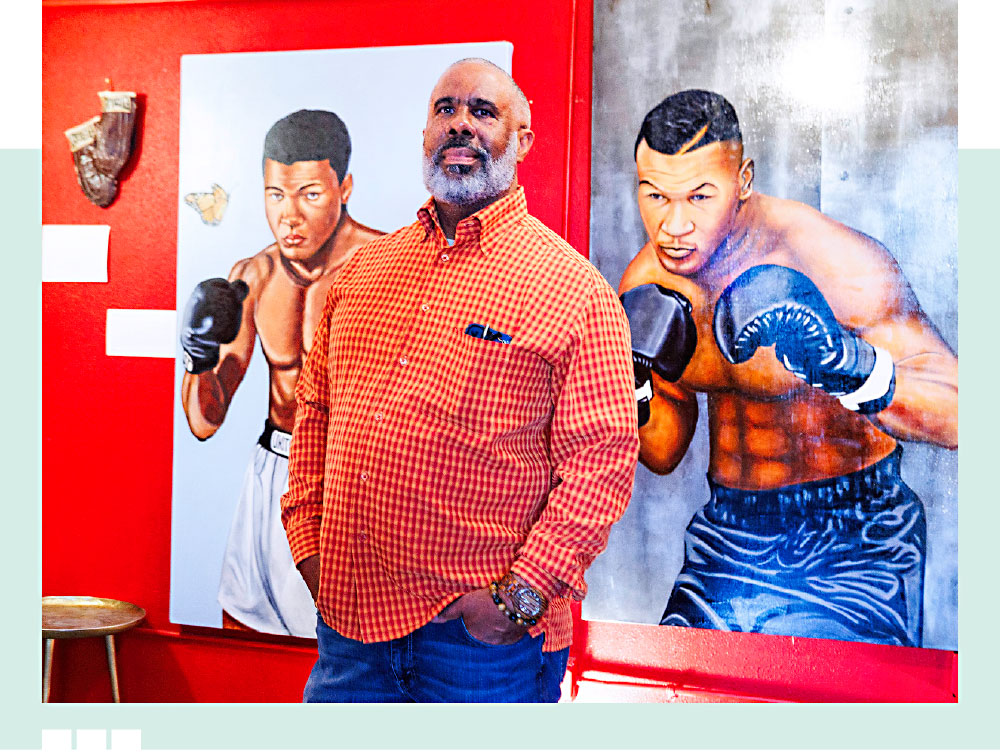
Despite a longtime interest in art, Bunn didn’t pursue the practice seriously until after his retirement. He graduated from UT-Austin with a BFA in studio art in 2020, where he learned that many public school art teachers must purchase their own supplies for their classrooms. He plans to donate his “Elevate” scholarship to the cause at low-income schools in his home of Georgetown.
Abstract artist Hailey Gearo met Samuel in 2021 and has participated in several RichesArt shows, including the first “American History” exhibit. But as she tells the Chronicle, her output has evolved to reflect her interest in storytelling – especially when it comes to her journey with bipolar disorder. Titled Worlds, the dreamscapes she’s showing in this year’s exhibit represent cyclical modes of being: bright colors populate what she calls her manic “phantasmal” state, while splatters and dots of muted tones signal depressive episodes. The series originated from a need for self-expression, but Gearo hopes to ignite wider conversations about mental health, especially in the Black community, where such vulnerability remains a taboo.
She’s inspired some conversations already. “Women of color, I’ve noticed, do this a lot,” Gearo begins. “They will read my artist statement and then look at whatever pieces they might be looking at, and then they’ll come over quietly and just say, 'Thank you for sharing.’ And then just disappear.”
It’s sweet and sad, Gearo says. “[It’s] one of those quiet glances that I feel like so many women have with each other .... So much of our communication is just seeing and being received in a very subtle manner.”
Meanwhile, the men who view Gearo’s work are moved to share their own emotions. “They are so conditioned to not feel or be expressive of their feelings, especially things that are outside of anger, because anger seems to be the easiest or most acceptable form for so many men to feel,” the artist posits. “And so having these really vulnerable moments with them is always really beautiful and also very inspiring [for] me to continue to put myself out there.”
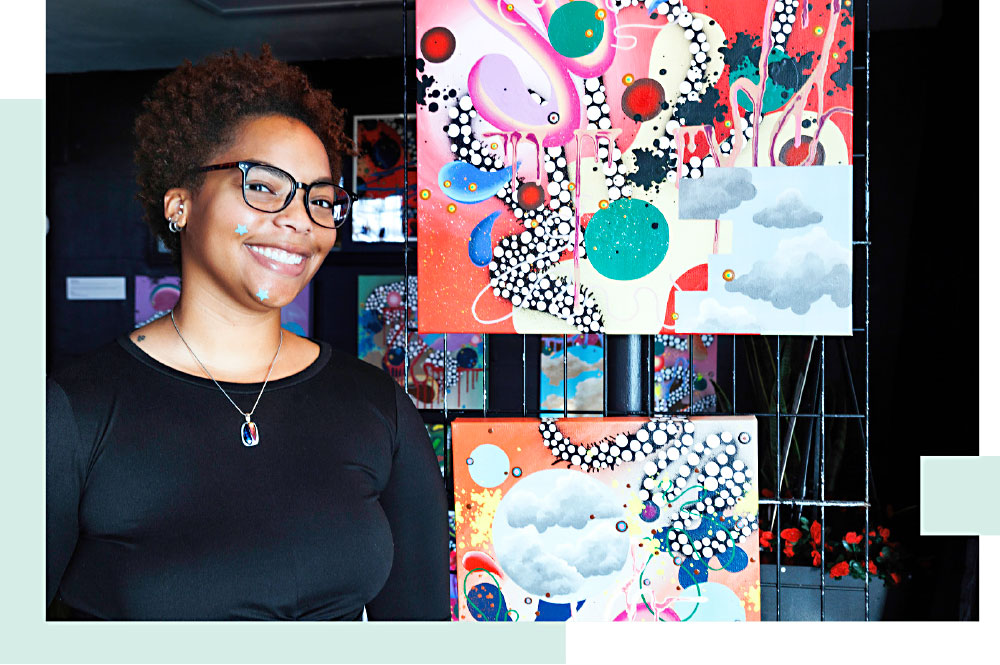
On the other end of the thematic spectrum, Of Color founder Hatchett submitted a photography series that depicts Black life and, most importantly, Black joy. He memorializes weddings and concerts; in one photo, two men get down on the dance floor, while in another, folks do the limbo. In modern America, where Black death is projected on 24-hour news programs and Hollywood reaps historical oppression to create Oscar-bait dramas, Hatchett’s candids offer a glimpse into normal Black life, down to the minutiae that make us human beings.
Equally striking are the photographer’s portraits, which reveal just as much about their subjects. In one shot, a woman bends over laughing, exposing the braces that match her Beyoncé-inspired chrome top. In another, shot in black-and-white, two women lean their heads together; one looks at the camera, while the other closes her eyes. Devoid of airbrushing, you can see the texture of their skin.
Artist and fashion designer DaProphet’s paintings are similarly positive. His work draws on a collective Black experience, “from watching Soul Train to eating at Waffle House on Sundays,” he says. “My hope is to bring back nostalgia.”
DaProphet’s images of Black Power fists and games of cards and dice instantly evoke Black culture, but his Waffle House painting will invoke a particularly visceral reaction in a very specific demographic. Miraculously, the piece turns the beloved, albeit chaotic, Southern breakfast chain into something of a blissful Monet scene. The black-and-white tiled floor, those cherry red barstools, the jukebox, a couple wrapped around each other: It’s all there, depicted with blurred brush strokes. Reader, DaProphet has taken the most care in depicting Waffle House since Anthony Bourdain’s impassioned Parts Unknown monologue.
Samuel, always the optimist, can already imagine how a future Austin will benefit from the “Elevate” exhibit, which runs until March 24. “Maybe 10 years from now, [we’ll] have three different programs that we can all translate back to 'American History: Elevate,’” he says. “And at that point, we’re creating the history that we want to see, creating the culture we want to see, creating the world we want to see. And,” he says again, “making history.”
Till Death Give Us Art
Walking through the spacious maze that is RichesArt, you find more rooms – and more Samuel projects. Right off the main space, which hosts the gallery’s art classes and entertainment shows, is a gift shop, where prints of Samuel’s work and clothes from his fashion line are up for sale.
Did we not mention his fashion line?
Rich Prophet is a collaboration between Samuel and DaProphet. The former describes the business as “upcycled high fashion street fashion” – consisting of altered pieces of existing clothing, to clarify the mouthful. Imparting a casual streetwear vibe onto more professional clothing, the line features a lot of modified suits: Samuel paints graffiti-esque designs on the back of sport coats, many of which have been cut into short sleeves.
There aren’t a ton of clothes for sale in the gift shop, but during the gallery’s open hours, fashion fiends can find Rase House, a vintage store tucked in the very back of the building that’s operated by Christa, Samuel’s mother. Turns out Richard wasn’t the only person in his family with a creative eye.
Now that he’s used every inch of his building’s 3,600 square feet, Samuel readies an expansion. Officially open today, Feb. 9, on East Cesar Chavez Street, RichesArt Studios touts photography rooms and a podcasting studio, offering a creation space to its ever-growing network of artists. Even without a playbook, the artist has clearly done something right.
“As someone that has been able to hold that community space and expand, I’ve just been in awe of [Samuel’s] ability to move and create, and do it in a very organic way that few artists before him have been able to do,” Hatchett says. “Especially at a young age.”
Samuel sums up his determination with his slogan, sold on gallery merchandise and projected into the space via light-up sign: “Till Death Give Us Art.”
A trademarked spin on marriage vows seems especially fitting for an artist clearly married to his work. “It’s a lifestyle,” Samuel says. “You go back and you look at your life and the things that you did and [what] brought life into your world or inspired you or made you light up, and so much of it is art-related.”
In other words? “I can lead, and leave, a happy life if I know that I was constantly creating.”
“American History: Elevate” is on display at RichesArt Gallery, 2511-A E. Sixth, through March 24.





